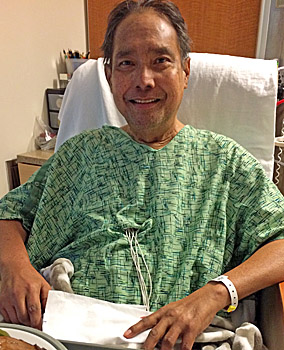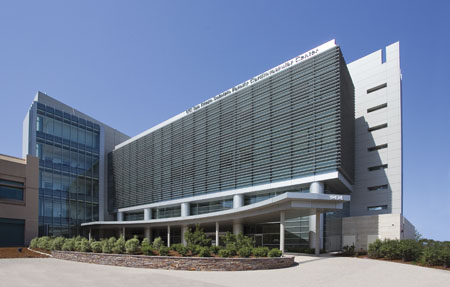UC San Diego Health Performs Region’s First Heart-Liver Transplant
Published Date
By:
- Jackie Carr
Share This:
Article Content
On November 4, 2016, surgeons at UC San Diego Health performed the region’s first combined heart-liver transplant (CHLT). During the 10-hour surgery, 54-year old Frank “Sonny” Taitano received a healthy heart and liver. This is the first successful heart-liver transplant for San Diego; less than 10 of these surgeries are performed each year in the U.S.
“I thank everyone at UC San Diego from the bottom of my new heart and liver,” said Taitano, father of six children and grandfather of thirteen. “I owe the team here everything. After these transplants, it is like nothing was ever wrong with me. I went in one door very sick and came back out a new person. I can breathe again. I can speak again.”
“These lifesaving surgeries represent the monumental effort and coordination of two advanced surgical teams,” said Victor Pretorius, MBchB, surgical director of cardiac transplant and mechanical circulatory support at UC San Diego Health. “UC San Diego has invested in the personnel, equipment and facilities to do this type of high-risk transplant surgery safely and effectively for the benefit of the community. It’s a joy to see Mr. Taitano getting back to the life he loves.”

During a 10-hour surgery, Frank “Sonny” Taitano received a new heart and liver at UC San Diego Health.
As the region’s only academic health system, UC San Diego Health has a comprehensive organ transplantation program and performs combinations of surgeries not performed in other hospitals, such as combined heart-lung, lung-liver-pancreas, liver-pancreas-kidney and heart-lung-liver transplantation. Graft survival after CHLT is similar to a heart or liver transplant — 80 percent at one year and 70 percent at 10 years.
“This is a relatively rare and complex procedure that can only be taken on by the most advanced teams with strong multidisciplinary collaboration,” said Alan Hemming, MD, surgeon and chief of Transplantation and Hepatobiliary Surgery at UC San Diego Health. “We also must remember the donors and their families to whom we are deeply grateful and without whom this gift of life would not be possible.”
Hemming, who performed the liver transplant, noted that while few heart-liver transplants are performed, patient’s survival at experienced centers is similar to receiving a heart or liver alone. In uncommon instances where the recipient has a low level of antibody against the donor, the donor liver may offer some degree of immunologic protection by clearing those antibodies before they can damage the heart.
Taitano was on a waiting list for more than 155 days. To extend his life while a suitable heart-liver match was found, he was placed for more than 50 days on a cardiac mechanical pump, called the Impella 5.0. Previously unreported in medical literature, this was the first time that this type of device has been used to sustain a patient for a CHLT.
“Because Frank became increasingly ill while on the wait list, this device was his only shot to stay alive for a transplant,” said Eric Adler, MD, cardiologist and director of cardiac transplant and mechanical circulatory support. “About a month ago, we were not sure that he would make it but the device did the job by serving as a bridge to a combined heart-liver transplant. The results have been spectacular and deeply gratifying for all involved.”
“By donating your organs, you give people like me a second chance at life. It’s happiness all around, for everyone,” said Taitano.
Organs from one donor can save or help as many as 50 people. To register as a donor, please visit: www.donateLIFEcalifornia.org

UC San Diego Health is a leader in organ transplantation and performs combinations of surgeries not performed in other hospitals.
UC San Diego Health is the only local hospital to perform heart-lung, living donor liver, and multi-organ chest-abdominal transplants. It has performed 28 heart transplants in the previous 12 months. For six consecutive years, U.S. News & World Report has ranked UC San Diego Health as the #1 adult hospital in the San Diego region.
More about transplantation at UC San Diego Health may be learned at: health.ucsd.edu/specialties/surgery/transplant
Share This:
You May Also Like
Stay in the Know
Keep up with all the latest from UC San Diego. Subscribe to the newsletter today.



